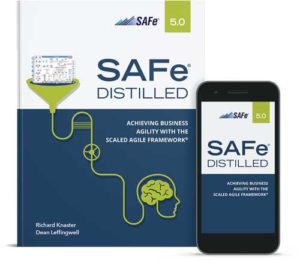Books on SAFe
Industrial DevOps: Build Better Systems Faster
by Dr. Suzette Johnson and Robin Yeman
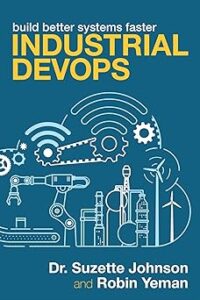
The benefits of adopting agile ways of working are well-understood in the digital world. But those in cyber-physical systems (combining software, hardware, and firmware) think it is risky. But with today’s speed of change, maybe the risk is in not changing.
Industrial DevOps: Build Better Systems Faster shows readers how applying Agile and DevOps ways of working into cyber-physical systems presents the opportunity to reap huge rewards, including increased adaptability, shorter delivery schedules, reduced development cost, increased quality, and higher transparency into delivery.
This book shows you how to couple the results of Agile and DevOps implementation in development with Lean and Agile in manufacturing. Through a successful application of nine key principles, Industrial DevOps provides the foundational success patterns for the development of cyber-physical systems in the digital age. The benefits that have been obtained across industries can be transferred to the cyber-physical domain and they have the potential to provide an even greater impact in the delivery of products.
SAFe® Coaches Handbook: Proven tips and techniques for launching and running SAFe® Teams, ARTs, and Portfolios in an Agile Enterprise
By Darren Wilmshurst and Lindy Quick
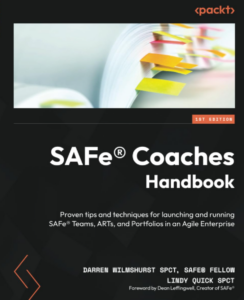
The Scaled Agile Framework (SAFe®) is widely recognized as an eff ective methodology for implementing Agile practices at the Enterprise level. However, the complexity of SAFe® can make it challenging for Teams and organizations to determine which practices can be safely adapted to their unique needs. Although SAFe® is a framework rather than a set of rules promoting adaptation, it’s crucial to understand why SAFe® practices are designed the way they are along with the consequences of modifying them.
The SAFe® Coaches Handbook is a comprehensive resource that goes beyond a how-to guide, providing a deep understanding of SAFe® principles and practices. The chapters are designed in a way to teach you how to successfully implement SAFe® in your organization and effectively manage the Team’s Backlog while avoiding common pitfalls. You’ll discover optimal ways to create SAFe® Teams and run successful Events. You’ll also learn how to plan Agile Release Trains (ARTs), manage the ART Backlog, conduct PI Planning, and grasp the importance of Value Stream Identification in driving value delivery.
By the end of this book, you’ll be armed with practical tips and advice to help you successfully customize the Scaled Agile Framework to your Enterprise’s needs while preserving the aspects that make it work successfully.
SAFe for DevOps Practitioners: Implement Robust, Secure, and Scaled Agile Solutions with the Continuous Delivery Pipeline
by Robert Wen
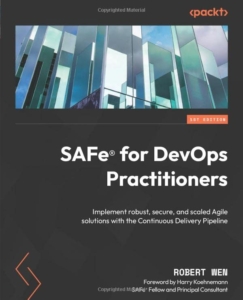 Product development and release face overlapping challenges due to the combined pressure of delivering high-quality products in shorter time-to-market cycles, maintaining proper operation, and ensuring security in a complex high-tech environment. This calls for new ways to overcome these challenges from design to development, to release, and beyond. SAFe® for DevOps Practitioners helps practitioners apply a DevOps technical approach with the Scaled Agile Framework and details how value streams help resolve these challenges using examples and use cases.
Product development and release face overlapping challenges due to the combined pressure of delivering high-quality products in shorter time-to-market cycles, maintaining proper operation, and ensuring security in a complex high-tech environment. This calls for new ways to overcome these challenges from design to development, to release, and beyond. SAFe® for DevOps Practitioners helps practitioners apply a DevOps technical approach with the Scaled Agile Framework and details how value streams help resolve these challenges using examples and use cases.
SAFe practitioners will connect with the book’s organizing structure around CALMR, value streams, and SAFe’s Continuous Delivery Pipeline (CDP). The book begins by explaining how the CALMR approach makes DevOps effective in resolving product development roadblocks. Next, you’ll learn to apply value stream management to establish a value stream that enables product development flow, measure its effectiveness through appropriate feedback loops, and find ways of improving it. Finally, you’ll get to grips with implementing a continuous delivery pipeline that optimizes the value stream through four phases, from continuous exploration to release on demand.
SAFe® 5.0: The World’s Leading Framework for Business Agility
“Those who master large-scale software delivery will define the economic landscape of the twenty-first century. SAFe 5.0 is a monumental release that I am convinced will be key in helping countless enterprise organizations succeed in their shift from project to product.”
Dr. Mik Kersten, CEO of Tasktop and author of the book Project to Product
Business agility is the ability to compete and thrive in the digital age by quickly responding to unprecedented market changes, threats, and emerging opportunities with innovative business solutions.
SAFe® 5.0 Distilled: Achieving Business Agility with Scaled Agile Framework® explains how adopting SAFe helps enterprises use the power of Agile, Lean, and DevOps to outflank the competition and deliver complex, technology-based business solutions in the shortest possible time. This book will help you
- Understand the business case for SAFe: its benefits, and the problems it solves
- Learn the technical, organizational and leadership competencies needed for business agility
- Refocus on customer centricity with design thinking
- Better align strategy and execution with Lean Portfolio Management
- Learn the leadership skills needed to thrive in the digital age
- Increase the flow of value to customers with value stream networks
Available in paperback, Kindle and epub formats.
SAFe® 4.5 Distilled: Applying the Scaled Agile Framework® for Lean Software and Systems
by Richard Knaster and Dean Leffingwell
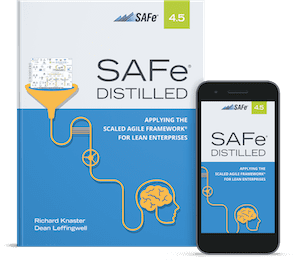 In today’s fast-paced digital economy, businesses must rapidly respond to advances in technology to maintain a competitive edge. Software and systems are everywhere, driving business innovation and new ways of working, while replacing aging business models.
In today’s fast-paced digital economy, businesses must rapidly respond to advances in technology to maintain a competitive edge. Software and systems are everywhere, driving business innovation and new ways of working, while replacing aging business models.
However, many enterprises struggle to develop significant software and systems—the modern fabric of nearly every product, in every industry across the planet. Companies are increasingly seeking to adapt by using agile principles and practices but many are still changing too slowly, and can’t sustain change. Fortunately, a growing number of enterprises have found a far more effective solution: the Scaled Agile Framework (SAFe). SAFe changes the game by integrating Agile, Lean and product development flow thinking with a new operating model that successfully coordinates work at all levels: team, program, value stream and portfolio. SAFe helps managers learn to become lean-agile leaders, working with teams to continuously improve their systems, and create environments where everyone flourishes.
In SAFe Distilled, Richard Knaster and Dean Leffingwell show leaders and practitioners how to achieve faster time to market, higher productivity, improve the quality of their technology solutions, and bridge the divide between executives, managers and practitioners, aligning everyone towards common goals and objectives. If you want to scale and sustain Agile in the enterprise, and more importantly get significantly better business outcomes, SAFe can get you there. SAFe Distilled will help you launch it, quickly earn value from it, and grow its value with every new endeavor.
SAFe® 4.5 Reference Guide: Scaled Agile Framework® for Lean Enterprises
by Dean Leffingwell with Richard Knaster, Inbar Oren, and Drew Jemilo
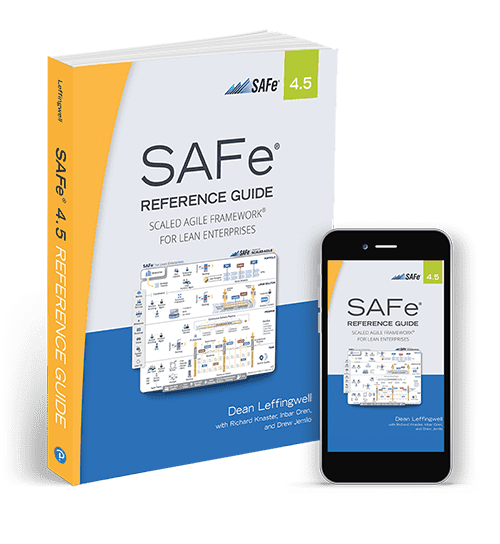 Fully updated to include the new innovations in SAFe 4.5, the SAFe® 4.5 Reference Guide is a handy desktop reference to help you accomplish your mission of building better software and systems. Inside, you’ll find complete coverage of scaledagileframework.com, the knowledge base that thousands of the world’s largest brands turn to for building better software and systems. This new edition also includes 14 advance topics articles and a revised glossary. The SAFe Reference Guide is now available at Pearson’s InformIT online store in paperback and eBook formats (including Kindle) and will soon be available at major book retailers (on or before June 14th). Please use the promotional code “SCALEDAGILE,” discount to receive a 35% discount at InformIT.
Fully updated to include the new innovations in SAFe 4.5, the SAFe® 4.5 Reference Guide is a handy desktop reference to help you accomplish your mission of building better software and systems. Inside, you’ll find complete coverage of scaledagileframework.com, the knowledge base that thousands of the world’s largest brands turn to for building better software and systems. This new edition also includes 14 advance topics articles and a revised glossary. The SAFe Reference Guide is now available at Pearson’s InformIT online store in paperback and eBook formats (including Kindle) and will soon be available at major book retailers (on or before June 14th). Please use the promotional code “SCALEDAGILE,” discount to receive a 35% discount at InformIT.
Tribal Unity: Getting from Teams to Tribes by Creating a One Team Culture
by Em Campbell-Pretty
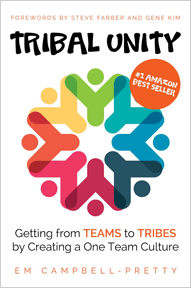 Tribal Unity is a real world, practical guide, for Lean-Agile Leaders committed to making their organizations truly great places to work. In Tribal Unity, SAFe Fellow Em Campbell-Pretty draws a parallel between tribes and the Agile Release Train, highlighting the impact of culture on effectiveness.
Tribal Unity is a real world, practical guide, for Lean-Agile Leaders committed to making their organizations truly great places to work. In Tribal Unity, SAFe Fellow Em Campbell-Pretty draws a parallel between tribes and the Agile Release Train, highlighting the impact of culture on effectiveness.
Based on many years of field experience, Tribal Unity is a ‘culture first’ approach to launching and operating SAFe Agile Release Trains, providing a step-by-step roadmap for scaling culture beyond a single team to a team of teams. Filled with concrete practices, illustrated through personal anecdotes, this book serves as an inspiration for those wanting to transform the culture of their organization. Put simply Tribal Unity is a distillation of proven patterns that are revolutionizing the way teams of teams connect and perform.
The ART of Avoiding a Train Wreck: Practical Tips and Tricks for Launching and Operating SAFe Agile Release Trains
by Em Campbell-Pretty and Adrienne L. Wilson
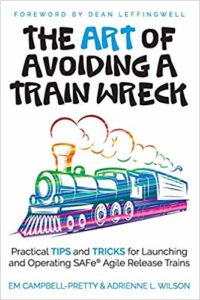 In The ART of Avoiding a Train Wreck, Em and Adrienne share their “trade secrets” for launching and operating powerful and effective Agile Release Trains. There’s a lot at stake when launching an Agile Release Train. When taking on an Enterprise Lean-Agile Transformation you only get one shot at a first impression. Runaway trains are expensive. Money gets wasted, time gets lost and the reputational damage can take years to repair.
In The ART of Avoiding a Train Wreck, Em and Adrienne share their “trade secrets” for launching and operating powerful and effective Agile Release Trains. There’s a lot at stake when launching an Agile Release Train. When taking on an Enterprise Lean-Agile Transformation you only get one shot at a first impression. Runaway trains are expensive. Money gets wasted, time gets lost and the reputational damage can take years to repair.
Going well beyond the standard SAFe training, this book deep dives into the practical tips and tricks that only over 15 years of combined real-world experience can teach. Peppered with innumerable war stories, this book provides plenty of entertainment (as well as education) in the form of personal anecdotes, cautionary tales and pro-tips for both the colocated Agile Release Train and its more complicated globally distributed cousins.You will learn how to get a ticket on the SAFe railway, load the cargo on your train, set the timetable, SAFely board and stay on the tracks. No matter your context, you are sure to find plenty of actionable ideas for launching and operating Agile Release Trains. Let’s face it, any train can derail, so let The ART of Avoiding a Train Wreck be the coach in your pocket, warning you of the obstacles on the tracks ahead before you train wreck.
The Rollout: A Novel about Leadership and Building a Lean-Agile Enterprise
by Alex Yakyma
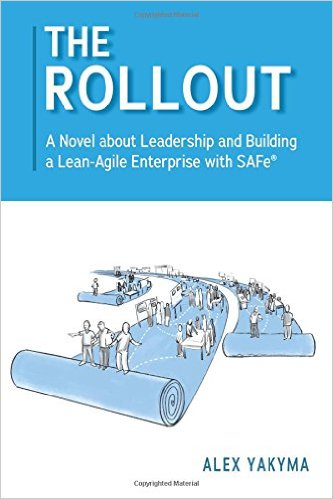 Are you a change agent, consultant, coach or Lean-Agile leader? If so, then this novel about leadership and building a Lean-Agile enterprise is for you!
Are you a change agent, consultant, coach or Lean-Agile leader? If so, then this novel about leadership and building a Lean-Agile enterprise is for you!
Fictional but based on a broad range of real-life SAFe implementations, the book features Ethan, the newly appointed transformation team leader at VeraComm Systems. He finds himself in the middle of turbulent action—the company has failed to cope with the increasing complexities of building competitive communications solutions, and is rapidly losing market share. Caught between a traditional approach to program and portfolio management, and half-baked Agile methods at the team level, he struggles to help his company find a way out. Ethan finally discovers a glimpse of hope—a method that applies the notion of agility at a much higher scale. Inspired by this discovery, Ethan charges into action, launching the rollout of a new method at his company. But in no time, he runs into a many obstacles. which puts the rollout, and his own career, in grave danger. You will be quickly immersed into an action-packed story of a transformation that will change your concept of adopting Lean and Agile at scale. This book will help you will learn many lessons about leading a Lean-Agile transformation, before you venture out on your own and possibly make some critical missteps. “The Rollout” will provide you with many techniques and tools to support large-scale rollouts of Lean and Agile methods. It will guide you through:
- Acquiring a Lean-Agile leadership mindset, which enables creating the right habits and culture
- Training stakeholders and teams
- Launching Agile Release Trains and supporting value delivery
- Relentlessly improving the system in which people work, as a whole
- Advancing engineering practices
- Organizing teams and trains around value
- Building a Lean-Agile portfolio
- Effectively leading change in the organization
Agile Software Requirements: Lean Requirements Practices for Teams, Programs, and the Enterprise
by Dean Leffingwell
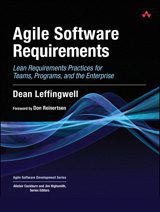 Effective requirements discovery and analysis is a critical best practice for serious application development. Until now, however, requirements and Agile methods have rarely coexisted peacefully. For many enterprises considering Agile approaches, the absence of effective and scalable Agile requirements processes has been a showstopper for Agile adoption. In Agile Software Requirements, Dean Leffingwell shows exactly how to create effective requirements in Agile environments.
Effective requirements discovery and analysis is a critical best practice for serious application development. Until now, however, requirements and Agile methods have rarely coexisted peacefully. For many enterprises considering Agile approaches, the absence of effective and scalable Agile requirements processes has been a showstopper for Agile adoption. In Agile Software Requirements, Dean Leffingwell shows exactly how to create effective requirements in Agile environments.
This book will help you leverage the benefits of Agile without sacrificing the value of effective requirements discovery and analysis. You’ll find proven solutions you can apply right now–whether you’re a software developer or tester, executive, project/program manager, architect, or team leader.
Scaling Software Agility: Best Practices for Large Enterprises
by Dean Leffingwell
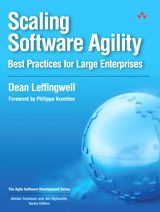 Agile development practices, while still controversial in some circles, offer undeniable benefits: faster time to market, better responsiveness to changing customer requirements, and higher quality. However, agile practices have been defined and recommended primarily to small teams. In Scaling Software Agility, Dean Leffingwell describes how agile methods can be applied to enterprise-class development.
Agile development practices, while still controversial in some circles, offer undeniable benefits: faster time to market, better responsiveness to changing customer requirements, and higher quality. However, agile practices have been defined and recommended primarily to small teams. In Scaling Software Agility, Dean Leffingwell describes how agile methods can be applied to enterprise-class development.
This book is invaluable to software developers, testers and QA personnel, managers and team leads, as well as to executives of software organizations whose objective is to increase the quality and productivity of the software development process but who are faced with all the challenges of developing software on an enterprise scale.
Last Update: 27 June 2017
